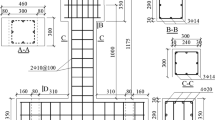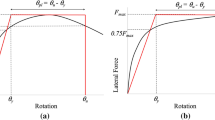Abstract
The seismic performance of steel reinforced engineered cementitious composite (RECC) short columns was investigated in this study. RECC columns with various shear span-to-depth ratios, axial load levels and transverse reinforcement ratios, together with one control reinforced concrete (RC) short column, were tested under the combined action of constant axial loading and reversed cyclic lateral loading. Test results indicate that RECC columns are superior to RC columns in terms of ductility, energy dissipation capacity and damage tolerance. The control RC column and the RECC column with the smallest shear span-to-depth ratio (of 1.42) were found to fail in shear. All other RECC columns, with higher shear span-to-depth ratios, including one RECC column without stirrups, failed in a flexure-dominated manner. Furthermore, theoretical flexural strength and shear strength expressions of RECC columns were derived and validated by the test results.







Similar content being viewed by others
Abbreviations
- A eff :
-
Effective shear area of section, A eff = 0.8A g
- A g :
-
Gross area of section
- A sv :
-
Total cross-section area of transverse reinforcement within spacing s
- b :
-
Width of column
- d :
-
Effective depth of column
- E :
-
Modulus of elasticity
- E d :
-
Energy dissipation coefficient
- E i :
-
Energy dissipation of the ith cycle
- f c :
-
Cylinder compressive strength
- f c,u :
-
Cubic strength
- f t0 :
-
Cracking stress of ECC
- f t1 :
-
Maximum tensile stress of ECC
- f y :
-
Yielding stress of longitudinal reinforcement
- f yv :
-
Yielding stress of transverse reinforcement
- k μ :
-
Factor for influence of ductility on concrete shear capacity
- K i :
-
Secant stiffness of specimen for the ith cycle
- N :
-
Applied axial load on column
- s :
-
Spacing of transverse reinforcement
- V cr :
-
Measured shear force of initial diagonal cracking
- V ECC :
-
Contribution of ECC to shear strength
- V i :
-
Maximum lateral load for the ith cycle
- V max :
-
Maximum shear strength of column
- V m :
-
Equivalent shear force, V m = M/H 0
- V n :
-
Predicted shear strength
- V s :
-
Contribution of transverse reinforcement to shear strength
- V y :
-
Yield shear force of column
- \(\bar{V}_{\hbox{max} }\) :
-
Average maximum strength of both direction
- δ u :
-
Ultimate drift ratio of column
- Δ i :
-
Displacement of column for the ith cycle
- Δ max :
-
Displacement corresponding to the maximum shear force of column
- Δy :
-
Yield displacement of column
- \(\bar{\Delta }_{y}\) :
-
Average yield displacement of both directions
- ε t0 :
-
Tensile strain at cracking stress f t0
- ε t1 :
-
Tensile strain at maximum stress f t1
- ε tu :
-
Ultimate tensile strain
- ε c :
-
Compressive strain at peak stress f c
- ε cu :
-
Compressive strain at peak stress f c
- θ :
-
Shear crack angle
- λ :
-
Shear span-to-depth ratio, shear span is the distance from the bottom of the column to the center point of application of the horizontal load
- μ :
-
Displacement ductility of column
- μ Δ :
-
Measured displacement ductility of column
- ρ s :
-
Ratio of longitudinal reinforcement
- ρ sv :
-
Area ratio of transverse reinforcement, ρ sv = A sv/(bs)
References
Pan ZF, Li B (2013) Truss-arch model for shear strength of shear-critical reinforced concrete columns. J Struct Eng 139(4):548–560
Xiao Y, Martirossyan A (1998) Seismic performance of high-strength concrete columns. J Struct Eng 124(3):241–251
Li VC, Leung CKY (1992) Steady state and multiple cracking of short random fiber composites. J Eng Mech 188(11):2246–2264
Li VC, Stang H, Krenchel H (1993) Micromechanics of crack bridging in fiber reinforced concrete. Mater Struct 26(162):486–494
Qian SZ, Li VC (2007) Simplified inverse method for determining the tensile strain capacity of strain hardening cementitious composites. J Adv Concr Technol 5(2):235–246
Lee BY, Lee Y, Kim JK, Kim YY (2010) Micromechanics-based fiber-bridging analysis of strain-hardening cementitious composite accounting for fiber distribution. Comput Model Eng Sci 61(2):111–132
Moreno DM, Trono W, Jen G, Ostertag C, Billington SL (2014) Tension stiffening in reinforced high performance fiber reinforced cement-based composites. Cement Concr Compos 50(7):36–46
Li VC, Wu C, Wang SX, Ogawa A, Saito T (2002) Interface tailoring for strain-hardening polyvinyl alcohol–engineered cementitious composite (PVA–ECC). ACI Mater J 99(9):463–472
Li VC, Wu HC, Chan YW (1996) Effect of plasma treatment of polyethylene fibers on interface and cementitious composite properties. J Am Ceram Soc 79(3):700–704
Kanda T, Watanabe S, Li VC (1998) Application of pseudo strain-hardening cementitious composites to shear resistant structural elements. FRAMCOS-3, AEDIFICATIO Publishers, Freiburg, pp 1477–1490
Van Zijl GPAG (2007) Improved mechanical performance: shear behaviour of strain-hardening cement-based composites (SHCC). Cem Concr Res 37(8):1241–1247
Maalej M, Li VC (1994) Flexural/tensile strength ratio in engineered cementitious composites. J Mater Civ Eng 6(4):513–528
Van Zijl GPAG, Wittmann FH (2011) Durability of strain-hardening fibre-reinforced cement-based composites (SHCC), State-of-the-art report, RILEM TC 208 HFC, SC 2. Springer, New York, ISBN-13: 978-94-007-0337-7
Lepech MD, Li VC (2006) Long term durability performance of engineered cementitious composites. Restor Build Monum 12(2):119–132
Van Zijl GPAG, Slowik V, Toledo Filho RD, Wittmann FH, Mihashi H (2016) Comparative testing of crack formation in strain-hardening cement-based composites (SHCC). Mater Struct 49(4):1175–1189
Kesner K, Billington SL (2005) Investigation of infill panels made from Engineered Cementitious Composites for seismic strengthening and retrofit. J Struct Eng 131(11):1712–1720
Fischer G, Li VC (2002) Effect of matrix ductility on deformation behavior of steel-reinforced ECC flexural members under reversed cyclic loading conditions. ACI Struct J 99(6):781–790
Billington SL, Yoon JK (2004) Cyclic response of unbonded posttensioned precast columns with ductile fiber-reinforced concrete. J Bridge Eng 9(4):353–363
Sezen H, Moehle JP (2004) Shear strength model for lightly reinforced concrete columns. J Struct Eng 130(11):1692–1703
Yuan F, Pan JL, Dong LT, Leung CKY (2014) Mechanical behaviors of steel reinforced ECC or ECC/Concrete composite beams under reversed cyclic loading. J Mater Civ Eng 26(8):04014047
Fischer G, Li VC (2003) Deformation behavior of FRP reinforced ECC flexural members under reversed cyclic loading conditioned. ACI Struct J 100(1):25–35
Park R, Paulay T (1975) Reinforced concrete structures. Wiley, New York
Légeron F, Paultre P (2000) Behavior of high-strength concrete columns under cyclic flexure and constant axial load. ACI Struct J 97(4):591–601
Wu C, Pan ZF, Meng SP (2016) Cyclic constitutive model for strain-hardening cementitious composites. Mag Concr Res 2016. doi:http://dx.doi.org/10.1680/jmacr.15.00052
Pan ZF, Wu C, Liu JW, Wang W, Liu JZ (2015) Study on mechanical properties of cost-effective polyvinyl alcohol engineered cementitious composites (PVA–ECC). Constr Build Mater 78(3):397–404
Hognestad E, McHenry D, Hanson NW (1955) Concrete stress distribution in ultimate strength design. J Am Concr Inst 27(4):455–479
Pan ZF, Wang W, Meng SP, Qiao Z (2015) Study on mechanical properties of hybrid PVA fibers reinforced cementitious composites. J Tongji Univ 43(1):33–40 (in Chinese)
Xu L, Huang L, Wei C, Xu H, Deng F (2014) Experimental tests of seismic bearing capacity of steel-polypropylene hybrid fiber reinforced concrete columns. J Build Struct 35(8):95–103 (in Chinese)
American Concrete Institute (ACI) (2008) Building code requirements for structural concrete and commentary. ACI Committee 318, Farmington Hills
Li VC (2007) Engineered cementitious composite (ECC)—material, structure and durability performance. CRC Press, Boca Raton
Cai X, Xu S (2010) Study on corresponding relationships between flexural load-deformation hardening curves and tensile stress-strain hardening curves of UHTCC. Eng Mech 27(1):8–16 (in Chinese)
Li VC, Wang S (2002) Flexural behaviors of glass fiber-reinforced polymer (GFRP) reinforced engineered cementitious composite beams. ACI Mater J 99(1):11–21
Acknowledgments
The authors gratefully acknowledge the funding supports of the National Natural Science Foundation of China (Grant No. 51208093, 5141101015), the Doctoral Program of the Ministry of Education, China (Grant No. 20120092120021) and the Key Laboratory of Concrete and Prestressed Concrete Structures, Ministry of Education. The authors wish to thank Dr. Zhi Qiao, Dr. Chenhua Jin and Miss Jiwei Liu for their assistance in the experimental program.
Author information
Authors and Affiliations
Corresponding author
Ethics declarations
Funding
This study was funded by the National Natural Science Foundation of China (Grant No. 51208093, 5141101015), the Doctoral Program of the Ministry of Education, China (Grant No. 20120092120021).
Conflict of interest
The authors declare that they have no conflict of interest.
Rights and permissions
About this article
Cite this article
Wu, C., Pan, Z., Su, R.K.L. et al. Seismic behavior of steel reinforced ECC columns under constant axial loading and reversed cyclic lateral loading. Mater Struct 50, 78 (2017). https://doi.org/10.1617/s11527-016-0947-9
Received:
Accepted:
Published:
DOI: https://doi.org/10.1617/s11527-016-0947-9




